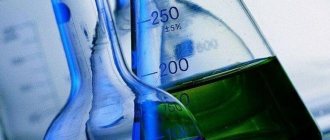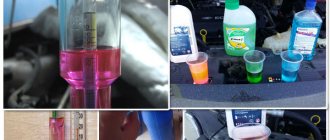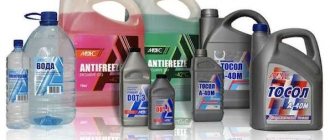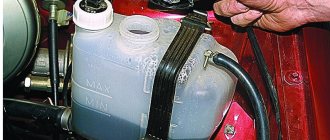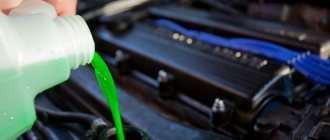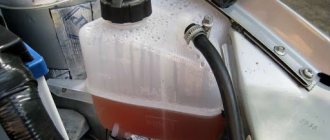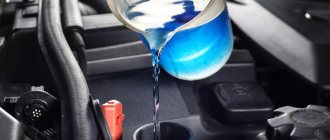The engine cooling system is an important component of the proper operation of the entire unit. As a result of using a car, it is periodically necessary to top up, and once every 3-5 years, completely change the coolant.
Coolant is available in two types:
- ready to use;
- concentrate.
Antifreeze in the form of a concentrate must be diluted with water before being poured into the radiator or tank. In its pure form, it is not intended for use as such; coolants with different freezing temperatures are prepared from it. There is one cooking method, the only difference is in the proportion depending on the desired operating temperature.
Antifreeze composition
The active substance in coolant is ethylene glycol. In the concentrate its content is 95-97%, the remaining 5-3% comes from additives and dye.
Antifreeze is colored according to three classifications:
- G11 – green, service life 3 years, used for all types of radiators;
- G12 – color from red to burgundy, filled in for a period of 5 years, carboxylate type additives, cover only corroded parts with a film;
- G13 – yellow, propylene glycol based, more environmentally friendly and expensive compared to G11, G12.
The latter is used in cars with forced engines, sports cars and motorcycles.
Percentage ratio when diluting liquid with distilled water
If you need to properly dilute antifreeze concentrate, then you should completely read the instructions, which are usually included with the packaging by manufacturers. In no case do not pour more water than necessary, because then the cooler will lose its properties. Don't forget about the climate conditions in which you live.
The table shows how to dilute antifreeze concentrate:
| Water percentage | Concentrate percentage | Freezing threshold | Boiling threshold |
| 87,5% | 12,5% | -7 | 100 |
| 75% | 25% | -15 | 100 |
| 50% | 50% | -40; -45 | +130; +140 |
| 40% | 60% | -50; -60 | +150; +160 |
| 25% | 75% | -70 | +170 |
Don't forget to take care of your car, because in winter it especially needs protection due to the drop in temperature. If you take into account all the recommendations about the method of using coolant and carefully read the label on the package, you will save yourself from constant major repairs of the car.
← Previous material
Next material →
How to dilute antifreeze
Do not dilute the concentrate with tap water. It contains many impurities that can not only neutralize the protective properties of the liquid, but also harm the engine.
As a result of such an error, the small channels of the cooling system may become clogged, which will reduce its efficiency and also lead to corrosion of some engine parts.
To dilute the concentrate, only distilled water can be used. It is sold in hardware and auto stores, in canisters of various sizes at a low price.
How to dilute antifreeze
Antifreeze should not only cool the engine, but also protect the power unit and cooling system parts from premature wear and corrosion.
Also, the water with which the concentrate is diluted must be purified from various salts and impurities. Please note that only distilled water can be poured into the cooling system!
- To protect the engine and cooling system, antifreeze uses a large number of active additives. However, if the concentrate is diluted with ordinary tap water, the effectiveness of the additives is noticeably reduced.
- Moreover, along with water, elements enter the system that act as catalysts for corrosion, contaminate surfaces, form persistent deposits on walls, etc.
- Ordinary water contains magnesium, chlorine, calcium and a number of other components.
This can cause the thin passages in the engine and radiators to become clogged, impairing engine cooling. We also recommend reading the article on how to flush the engine cooling system from scale and rust. From this article you will learn how to flush the cooling system, as well as what and how to flush the car's CO.
For these reasons, to dilute antifreeze concentrate, you must use clean distilled water that does not contain additional impurities.
Antifreeze concentrate: how to dilute
First of all, you can find red, green, blue, purple, etc. antifreeze concentrate on sale. Antifreezes may be of different generations and types, but this does not affect the process of diluting the concentrate. At the same time, different ratios of concentrate and water allow you to obtain different freezing temperatures.
Antifreeze concentrate is sold in different containers: 1 liter, 4 liters, 5 liters, etc. At the same time, the packaging usually contains instructions on how to dilute the antifreeze with water in one proportion or another.
Standard and widely used values:
- When the temperature in the region drops to -35 degrees and below, antifreeze is mixed with water 1:1 (1 liter of concentrate per 1 liter of water);
- If the winter temperature usually does not drop below - 20 degrees Celsius, you can dilute antifreeze in a 60/40 ratio, where 40% concentrate and 60% water.
- In regions with a temperate climate, where in winter the temperature does not drop below -10, antifreeze can be diluted in a ratio of 1/4.
Antifreeze concentrate, how to dilute, table:
We also add that in addition to the freezing threshold, it is important to pay attention to the boiling threshold.
Breeding rules
Before you start diluting the concentrate, you must carefully read the recommendations on the packaging. You cannot increase the proportion of water yourself, as this reduces efficiency. You also need to take into account the operating conditions of the vehicle and climatic conditions.
There are generally accepted proportions for bringing the liquid to working condition in the water/concentrate ratio:
- 7/1, freezing point -7, boiling threshold +100;
- 3/1, freezes at -15, boiling threshold +100;
- 1/1 freezing threshold -45, boils at +130;
- 2/3 freezes at -50, boils +150;
- 1/3 freezing threshold -70, boiling +170.
It is strictly forbidden to mix antifreeze of different colors.
Tips and tricks
To extend the service life of the cooling system, antifreeze must be selected correctly according to its properties and antifreeze must be replaced in a timely manner. Knowing how to dilute antifreeze concentrate and monitor the condition of the coolant in the cooling system also helps to avoid common mistakes:
- it is necessary to take into account in which climate zone the car is operated;
- Antifreeze concentrate should be diluted only with clean distilled water;
- periodically you need to check the density of antifreeze in the system;
We also recommend reading the article about why a car engine “boils” and overheats. From this article you will learn about the causes of engine overheating and ways to solve this problem.
Remember, the more water there is in the coolant, the higher the freezing point. However, increasing the amount of concentrate by more than 55% also does not allow obtaining high freezing resistance.
For this reason, it is necessary to dilute the antifreeze concentrate taking into account the proportions indicated on the package with the concentrate or in a special table.
Well-known brands of antifreeze concentrate
Not all companies producing ready-made coolants produce antifreeze in the form of a concentrate. Among a small number of such manufacturers, the best are rightfully recognized:
- MOBIL ANTIFREEZE ULTRA - class G13, usually used in new premium cars, the finished liquid in a 1/1 ratio has a high boiling point, about +160 degrees and a low freezing point of up to -45. Service life is 5 years.
- LIQUI MOLY KUHLERFROSTSCHUTZ KFS 2001 PLUS - class G12+, the reliable composition of which has proven itself excellent among car manufacturers VAG, Mercedes-Benz, BMW. Service life is 5 years. According to the manufacturer, it can be mixed with class G11 on a silicate basis, but in this form the period is reduced to 2 years.
- CASTROL RADICOOL SF is a carboxylate antifreeze, class G12, which has proven itself positively among owners of diesel cars. Replacement interval 3 years. Disadvantages include high chemical activity.
- Motul Auto Cool G13 - based on monoethylene glycol with a package of organic and inorganic additives.
- General Motors - G12 concentrate has an extended replacement interval.
There are concentrated liquids developed and produced by domestic manufacturers, these include:
- Gazpromneft Antifreeze SF 12+ - based on ethylene glycol, for internal combustion engines, including stationary ones;
- LUKOIL ANTIFREEZE G12 RED – a protective layer appears exactly at the point of corrosion, increasing service life.
The choice of coolant should be made based on the recommendations of the vehicle manufacturer and well-established manufacturers. Particular attention should be paid to the originality of the product, so as not to buy a fake, purchase from trusted sellers or large shopping centers.
Breeding technology and proportions
First, let's figure out exactly how to mix the concentrate with water so that you don't have to pour out the resulting composition later.
- The sequence of what to pour into does not matter. As well as the container in which mixing will take place. It is important to simply maintain the proportions.
- In some cases, pouring water into the expansion tank first, and then concentrate, is possible, but not advisable. Firstly, if you are preparing antifreeze immediately for a complete replacement, then the amount you calculated may not be enough. Or, conversely, you will end up with too much antifreeze. For example, you first poured 3 liters of concentrate, and then planned to add 3 liters of water. Since they knew that the total volume of coolant in the system is 6 liters. However, 3 liters of concentrate fit in without any problems, but only 2.5 liters of water went in. Because there was still old antifreeze in the system, or there was a non-standard radiator, or there was some other reason. And in winter, at temperatures below –13 °C, pouring liquids separately is strictly prohibited. Paradoxical but true: pure ethylene glycol (like antifreeze concentrate) freezes at a temperature of –13 °C.
- You cannot add concentrate from one coolant to another. There are known cases when, during such mixing, some of the additives conflicted and precipitated.
There are three most common proportions for mixing coolants:
- 1 to 1 – the output is antifreeze with a freezing point of approximately –35 °C;
- 40% concentrate, 60% water - you get a coolant that will not freeze to approximately -25 ° C;
- 60% concentrate, 40% water - antifreeze that will withstand temperatures down to -55 ° C.
To create antifreezes with other freezing points, there is a table below that shows a wider range of possible mixtures.
| Concentrate content in the mixture, % | Antifreeze freezing point, °C |
| 100 | –12 |
| 95 | –22 |
| 90 | –29 |
| 80 | –48 |
| 75 | –58 |
| 67 | –75 |
| 60 | –55 |
| 55 | –42 |
| 50 | –34 |
| 40 | –24 |
| 30 | –15 |
Coolant properties
Antifreeze is used not only for cars, but also for heating systems and aircraft engines. The liquid contains ethylene glycol and various additives
. They will improve not only the operation of the units, but also prevent their rapid wear. If the concentrate is diluted correctly, the coolant will provide the following conditions for the engine:
- the boiling point will be low or optimal;
- the service life will be long and without loss;
- rubber products will get rid of the aggressive influence on them;
- the boiling point will be high and the thermal conductivity will be high;
- anti-foam characteristics will be high.
Why dilute a concentrated refrigerant solution?
The cooler maintains the temperature parameters of the working area of the power unit at the level of 90-110 degrees Celsius. If the temperature in the engine exceeds these values, the vehicle’s power unit will overheat and fail. This cannot be allowed.
Antifreeze must always be in a liquid state in order to be successfully distributed through the engine channels and remove excess heat from working parts. Water cannot cope with this function, since it freezes at 0 degrees Celsius. This also applies to antifreeze concentrate. The crystallization temperature of the technical mixture is at minus 13 degrees.
To change the properties of the coolant, it must be mixed with water and alcohols, as a result the mixture acquires new characteristics. By dissolving the coolant, you can reduce the crystallization threshold of the substance, down to 70 degrees with a minus sign. It is noteworthy that when the coolant is diluted, the boiling point of the technical composition decreases, so it must be mixed correctly to achieve the required performance properties.
What are the differences between antifreeze in appearance?
In order to distinguish antifreeze from plain water or to see the location of a leak in the cooling system, manufacturers add a dye. But, various other components are also added to them, which give other properties to the liquid. And in order to distinguish what properties the components will provide, they are painted in different colors. Coolers of European or Japanese brands are often used.
According to European standardization, G11 antifreeze is colored green
. Components such as inorganic additives, which are included in this composition, provide operation for a period of three years and are used for all types of radiators.
Antifreeze such as G12 is red in color (or from pink to burgundy). The additives in this solution act selectively because they are of the carboxylate type. Therefore, this liquid will cover with a protective layer only the surface that is affected by corrosion. With such a concentrate, the service life will be 5 years.
G13 antifreeze is painted yellow (possibly a brighter shade of yellow). Since it is propylene glycol, the price is an order of magnitude higher because it is more environmentally friendly. It is used for sports or forced engines of passenger cars or various motorcycles.
It is common to use green coolant. Such a cooler freezes at a temperature of minus 25. If the temperature is minus 25, then you need to use green. For those countries where the temperature is about 30 degrees, you need to pour red concentrate into the engine tank.
Results
Is it necessary to mix the concentrate with the distillate? Yes, if we are talking about driving a car in harsh winter conditions. Traveling to hot places? In this case, you should not add water to the substrate, because the high operating temperature of the motor, coupled with the heat, will quickly put the engine out of operation, and having a maximum boiling point of 200 degrees is an excellent indicator of stability.
Another thing is that the cost of the concentrate is much higher than the finished product, so everyone decides for themselves what tricks to use in order to both save money and not subject the vehicle to increased loads on key power components. The situation is delicate and only experience will allow you to calculate the optimal dosage of distilled water in relation to antifreeze. Feel free to ask experienced car owners who will also be happy to share their skills.
What should you use to dilute the liquid?
There are two types of antifreeze sold in stores: diluted and in the form of a concentrate. The concentrate contains ethylene glycol, which freezes at a temperature of -13, so it is strictly forbidden to fill in undiluted coolant. Remember that antifreeze concentrate can only be diluted with distilled water, otherwise you will have many problems due to which the engine of your car will not receive the necessary protection and will break down.
Do not dilute with tap water, because it may contain various trace elements that, if they get into the cooler, will cause your car’s engine to corrode very quickly or may ruin its operation. There is no need to mix antifreeze concentrate of different brands and different colors
.
Video “Classification of antifreeze”
The video on our website will help you understand what types of coolants there are.
If you own a car, then you will need antifreeze concentrate to cool the engine. With the development of chemistry, there are now many different antifreezes, differing from each other depending on the properties they have. Antifreeze is a liquid that does not freeze at low temperatures.
